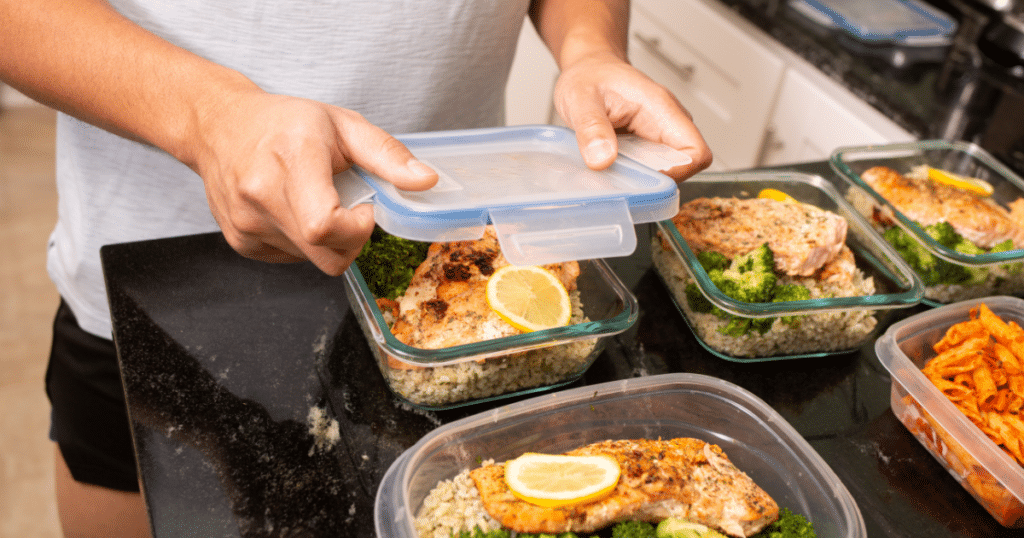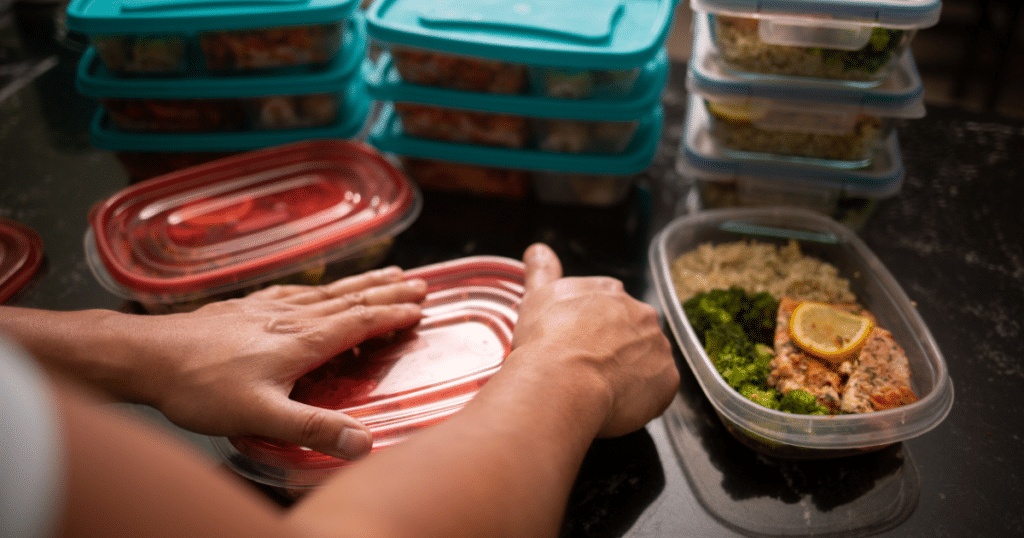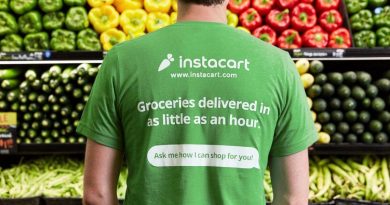Meal Prepping Simplified: Here’s Everything You Need to Know
In our fast-paced world, the demands of daily life can often leave us with little time or energy to focus on our nutritional needs. We find ourselves trapped in a cycle of convenience foods and takeout, sacrificing our health for the sake of saving a few precious minutes. But what if I told you there’s a simple, effective, and transformative solution right at your fingertips? Meal prepping!
Meal prepping, the art of preparing meals in advance, has emerged as a game-changer for those seeking to simplify their lives while nourishing their bodies. In this article, we’ll dive deeper into the wonderful world of meal prepping, uncovering the secrets to making it not just a habit but a joyful and sustainable part of your lifestyle. Say goodbye to mealtime stress and hello to a healthier, more efficient you!
Disclaimer: This article is for informational purposes only and is not meant to treat or diagnose any condition. It is recommended that you speak with your doctor before starting any exercise program, changing your daily nutrition, or adding any supplements to your regimen.
Table of contents

How to Start Meal Prepping
Embarking on your meal prepping journey may seem daunting at first, but fear not! With a few simple steps and a dash of determination, you’ll be well on your way to mastering this invaluable skill. Here’s a practical guide on how to start meal prepping:
- Set Clear Goals: Begin by defining your objectives. Are you meal prepping to save time, eat healthier, or manage your portions? Knowing your goals will help you tailor your meal prep approach.
- Plan Your Meals: Take some time to plan your meals for the week ahead. Start with a basic menu, including breakfast, lunch, dinner, and snacks. Keep in mind any dietary restrictions or preferences.
- Create a Shopping List: Based on your meal plan, compile a detailed shopping list. This will help you avoid impulse purchases and ensure you have all the ingredients you need.
- Invest in Containers: Get a variety of food storage containers in different sizes to accommodate different meals and portion sizes. Opt for reusable and eco-friendly options for sustainability.
- Choose a Prep Day: Dedicate a specific day each week for meal prepping. Sunday is a popular choice, but any day that suits your schedule works. Consistency is key.
- Cook in Batches: Prepare large batches of proteins (such as chicken, tofu, or beans), grains (rice, quinoa), and vegetables. This will save you time during the week.
- Mix and Match Ingredients: Keep your meals interesting by cooking versatile ingredients that can be combined in various ways. For instance, roasted vegetables can be used in salads, grain bowls, or as side dishes.
- Portion Control: Use your containers to portion out meals according to your planned servings. This helps prevent overeating and ensures balanced nutrition.
- Label and Date: Clearly label your containers with the meal name and date of preparation. This will help you identify items in the fridge and keep track of freshness.
- Store Properly: Store your meals in the refrigerator for up to a few days or in the freezer for longer-term storage. Be mindful of food safety guidelines.
- Rotate and Refresh: Consume your prepped meals throughout the week and replenish your stock as needed. This ensures you always have a variety of options at your fingertips.
- Stay Flexible: Life can be unpredictable, so don’t be too rigid with your meal prep. Allow for occasional dining out or adjustments to your plan to accommodate changing circumstances.
- Enjoy the Benefits: Embrace the newfound freedom that meal prepping provides. You’ll save time, money, and the stress of deciding what to eat. Plus, you’ll enjoy the health benefits of consistently consuming balanced meals.
Remember, meal prepping is a skill that improves with practice. Be patient with yourself as you get the hang of it, and don’t be afraid to experiment with recipes and ingredients. Soon enough, meal prepping will become a seamless and rewarding part of your routine, simplifying your life one delicious dish at a time.
Here’s How You Can Simplify Meal Prepping

Below are some of the strategies you can use when meal prepping:
1. Meal prepping the same foods every day
I’m not the norm here, as I can easily eat the same foods every single day — but most people aren’t weird like me. Therefore, why should you stick to those diets that tell you to eat chicken and brown rice or fish and asparagus for every meal? Sounds kinda boring, doesn’t it? The summer months are a great time for meal prepping!
Related Article: Meal Planning to Help You Achieve Your Goals
Not only that, but what if you don’t even like fish or another food option that is recommended? You’re going to lose interest in your meal prepping quite quickly. For that reason, you need to change it up and not eat the same foods all the time. Beef, chicken, fish, eggs, turkey, ham, heck… even tofu if that’s what you like. Just stop eating the same foods for every meal of every day. Include a variety to not only keep your sanity, but to also get a nice mix of vitamins and minerals from your food.
2. Not using condiments
If you are eating clean, that can mean no sauces, gravies, or other unhealthy toppings on your food. But, you’re in luck! There are some great low-calorie condiments that you can use to spice things up a little bit and add more dimension to what would normally be a boring dish.
For instance, you could top your food with Sriracha, Frank’s Red Hot Sauce, Mrs. Dash condiments (any of them), fresh salsa or Pico de Gallo, anything Walden Farms, mustard, stevia, Splenda, soy sauce, Tabasco sauces, Worcestershire sauce, salt and pepper, and just about any spice you can think of out there for meal prepping. Wake up your taste buds and pick up some of the examples listed and enjoy eating food again. Including some of these condiments will allow you to bring life to what would normally be mind-numbing dishes.
3. Restricting yourself
Doesn’t zucchini pasta sound amazing? No? Then why eat it? Because someone said you should in order to lose weight? That’s nonsense. Stop restricting yourself on what you should and shouldn’t eat (within reason). You can incorporate an IIFYM (if it fits your macros) plan into your regimen and have a little more flexibility in the foods you consume. Now, I’m not saying you should go out and eat junk all day long in order to get in your macros, but allow yourself to have fun and enjoy the process. You don’t even need to cut out pizza night with your family—just be more conservative on how much you consume and maybe add some healthy toppings like a vegetable (or put your own on).
If you completely restrict yourself from all “cheat foods” you will end up going insane and wind up binge eating everything in sight. If you’re not planning on hopping up on stage to compete, then enjoy treats every now and then and work them into your meal prep.
4. Only consume Tupperware meals
You know exactly what I’m talking about here with meal planning. We have all seen (or have been one of those people) friends or family members “dieting” and carrying around their Tupperware containers everywhere they go. If you eat out at a restaurant, they bring their Tupperware meal. Everyone in the office is going out to eat to celebrate a huge win at work, and you take your Tupperware. Holidays! Yay! You bring your Tupperware (and not for leftovers).

Do you hear how depressing that is sounding? Why are you doing it to yourself? If you understand nutrition to the point where you can make decisions based on what is a healthy and unhealthy food, then you can eat anywhere you want and find something that fits your individual nutrition plan when meal planning.
Heck, you can even stick to your nutrition plan and meal planning if you find yourself in line at your local McDonald’s. Don’t get stuck with nutritional tunnel vision. Expand outside of the Tupperware containers and enjoy the foods you consume. You can eat out and get food prepared exactly how you’d like (within reason). You can have things steamed rather than soaked in butter. Or have your chicken breast made without any BBQ sauce. Don’t be afraid of eating out.
5. Making bulk ingredients
Too many times I see people making Sunday a meal prep day. They make everything they are going to eat for the week on that one day and package it all up in the fridge. By Wednesday you’re so sick of one item you prepared that you say the heck with it and wind up throwing it away because you’re no longer hungry for that particular item. Stop preparing in bulk unless you have a ton of variety.
If you can, prepare only a few meals at a time to prevent yourself from getting bored with your food choices. Listen to yourself, not what others say. Change things up if you have to. Maybe you have chicken for a couple days and then decide you want to change it up for some meat. Awesome. That prevents you from making a week’s worth of chicken and throwing it away due to your appetite changing from one item to another.
Unless you know you can consume a protein source (or even a carbohydrate/fat) every day of the week, then make a variety of different food options that you can put together based on what you’re hungry for.


*Disclosure: This article may contain affiliate links or ads, which means we earn a small commission at no extra cost to you if you make a purchase through these links. These commissions help support the operation and maintenance of our website, allowing us to continue producing free valuable content. Your support is genuinely appreciated, whether you choose to use our links or not. Thank you for being a part of our community and enjoying our content.
PLEASE CONSIDER SHARING THIS ON YOUR SOCIAL MEDIA TO HELP OTHERS LEARN MORE ABOUT THIS TOPIC.





